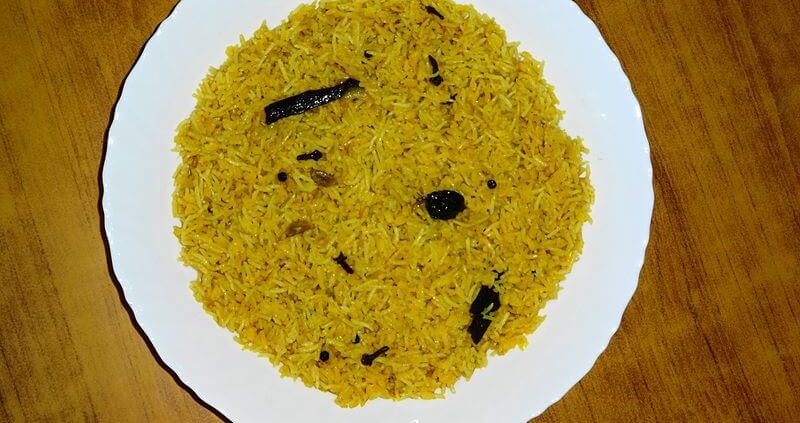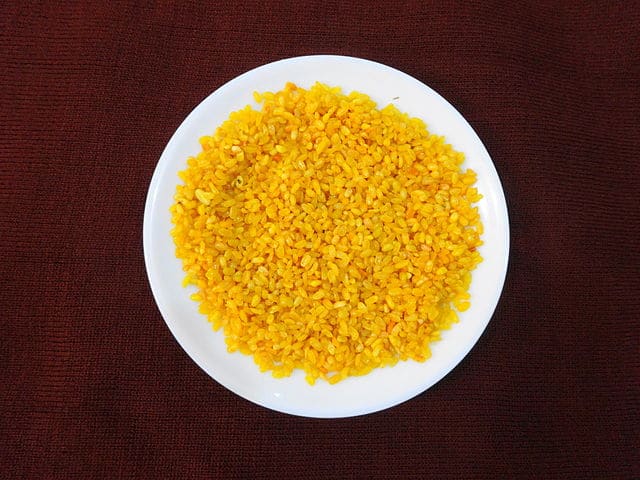Khichdi is an ancient Ayurvedic recipe which has been part of diet since ages.It is easy to digest and helps the body to detoxify.
I believe, you all must have heard about Khichri especially when someone in your family got ill or when someone was recovering from an illness.
A lot of people amongst you must have made faces after hearing the word khichdi.Some people are even reluctant to eat it as a substitute for fast food.
But the truth is that Khichri is a straightforward and healthy preparation which nourishes the body and cleanses it by draining out the toxins from the body.
It is one of the easiest preparation which constitutes of dal(lentils) and rice.It may be complemented by adding curd, yogurt, pickles or vegetables.Khichri’s popularity dates back to pre historic period and is still consumed by many people.
Table of Contents
What Is Khichdi?
Khichri is like an amenity and pleasure for Indian people. It is considered as a nourishing, light and simple meal without any spices.It is greatly acknowledged by doctors and recommended to patients especially children and elderly who are recovering from diseases.It is greatly liked by people who pursue a Saatvik diet of Ayurveda.
During the Mughal empire, classical khichdi went through various modifications. They supplemented by adding nuts, healthy spices and dry fruits. During Akbar rule, the royal cuisine made and distributed Khichri every day. Jahangir admired Khichri prepared with lots of Ghee, dried fresh fruit and nuts. The oldest registered recipe dates back to Akbar’s rule. Khichdi Recipe (Ain-I-Akbar).
A Russian explorer, Afanasiy Nikitin, who voyaged to India during the 16th century, declared that the Mughal ruler Jahangir promoted this dish, and it is postulated that Emperor Aurangzeb was affectionate about khichdi.
Alamgiri Khichri was developed for Aurangzeb. The khichdi recipe was customized to conform the Anglo-Indian delight, by adding fish and eggs to the ingredients during the British colonial regime (1858— 1947).
It was called Kedgeree, and became famous during the British era as a predominant breakfast food. It soon proliferated outside India to the UK during Queen Victoria’s command.
According to one hypothesis, however, it was taken to India by Scottish troops during the colonial era, where it was said to have become part of Indian menu. Later the dish found its way back to the UK. Despite that, ordinary assessment still regards khichdi a classic and beneficial dish, delicately spiced.
Health Benefits Of Khichdi
1.Nourishing Meal
Khichdi has a stable balance of carbohydrate and proteins. Moong beans that are the basic ingredient in khichdi, are a great source of dietary fiber, calcium, magnesium, phosphorus, Vitamin C and potassium.Not only this it comprises of 10 essential amino acids, making it a complete protein.
Freshly-prepared khichdi consumed with pure cow’s ghee provides the appropriate amount of macronutrients, proteins, complex carbohydrate and fat. Adding up vegetables while preparing khichdi adds up the nutritional value further.
2.Gluten-Free
People who are gluten sensitive or suffer from celiac disease have a problem in the processing of this gluten which is the storage protein found in certain grains like wheat, rice and barley. But they can choose to eat khichdi on alternate days as it provides enough nutrition and yet is light and gluten-free.
Many people who may not be suffering from this disease also select gluten-free food as a lifestyle change.They too can consume khichdi.
3.Balances Dosha
This dish can be served almost any time of the day, be it morning, evening or even at nights. It is easy to prepare. It is best known for its capacity to detoxify the body and stabilize the three doshas – Vata, Pitta, Kapha. It is a tridoshic food which has a soothing effect on the body.
A savoring and the nutritious dish of rice, moong cooked with ghee, and spices like salt and Haldi(turmeric), adds the balance of vital elements – earth and water for increasing energy and immunity and fire to stimulate digestive enzymes.
4.Easy To Digest
Khichdi when eaten with curd, is a calming food for the intestine and helps in adjusting an upset stomach. It is a generous meal loaded with nutrients for babies and elderly.It is easy for them to digest as both of them have a slow metabolism and their digestive strength is too weak to digest complex nutrients.
Side Effects Of Khichri
Khichri is a completely natural and a simple formulation. Therefore, no side effects of khichri so far have been noted.
Different Recipes For Preparing Khichiri
You may form your own Khichri with Rice, and a combination of legumes like moong and chana you prefer. You might even add vegetables and cracked wheat (Dalia).
‘Ghee’ is an important ingredient according to the traditional recipe. You may also add Nuts (Almonds, Pistachios, Cashews, Chirongi, Chilgoza), and dried fruits (Raisins, chopped apricots) to enhance its nutritional value as well as its garnishing and serving value.
The consistency of the finished product varies from being dry like a Biryani to wet depending on your taste and preference.
Normally Khichri is served with yogurt, Kadhi, and pickles. Traditional Khichri is not spicy; it is complemented with a pickle.
1st Method Of Preparation
Ingredients
- 1 cup basmati rice
- 1/2 cup split green moong beans (dal)
- 1 tbsp. clarified butter or Ghee
- 1 tsp. mustard seeds (optional)
- 1/2 tsp. cumin powder (this Indian spice is also called jeera)
- 1/2 tsp turmeric powder (Indian spice called Haldi)
- Pinch asafoetida powder (Indian spice is called Hing)
Preparation
- Clean the rice and dal separately by removing any debris or stones.
- Rinse both of them two to three times in cold water. Repeat this process until clean water comes out.Take this rice and dal in a pan or a cooking pot.
- Add 3 cups of water in the cooking pot and bring it to a boil. While simmering of dal and rice, prepare the spices.
- Add ghee to a heavy skillet placed over a medium heat.
- Add various spices like mustard seeds, cumin, turmeric and asafoetida powders according to your choice and taste. The mustard seeds will start to pop within a few seconds.
- Pour this spice mixture over the cooked rice and dal.
- Let it simmer for about 35 minutes. You can add more water at various intervals during cooking if you prefer a more soupy consistency at the end.
Tips While Preparation
Turmeric will stain khichri yellow.
Asafoetida smells bad but don’t worry it has no taste in the cooked food.It is used while cooking beans as it is helpful in removing the gas.
No need to soak the split moong beans. They normally cook fast.
One should avoid adding salt while the beans are being cooked because salt makes the beans tough. It can be added up later in the process.
2nd Method Of Preparation
Ingredients
- 1 cup split yellow moong dal beans
- ¼ – ½ cup white basmati rice
- 1 tbsp fresh ginger
- 1 tsp each: Cumin, turmeric powder and black mustard seeds
- ½ tsp each: Coriander powder, fennel seeds and fenugreek seeds
- 3 cloves
- 3 bay leaves
- 7-10 cup water
- ½ tsp salt (rock salt is best) or Bragg Liquid Aminos
- Some fresh cilantro leaves
You may add steamed vegetables or lean meat when the motive is not body cleansing, or it may be added for extra blood sugar support during a cleanse.
Preparation
- Wash the two main ingredients-moong dal and basmati rice well till we clean water after filtering.
- In a pre-heated large pot, dry roast all the spices (except the bay leaves) on medium heat for a few minutes.This will enhance the flavor of the mixture.
- Add dal and rice and stir both.Allow the rice and beans getting coated with the spices.
- Add water and bay leaves to the content and bring to a boil.
- Boil for 10 minutes.
- Turn the flame to low, cover the cooking pot and continue cooking until dal and rice become soft (it will take about 30-40 minutes).
- The cilantro leaves should be added just before serving.You may add salt as per taste.
How To Do A Kitchari(Khichdi) Cleanse?
Khichdi is a delicious Ayurvedic dish that’s known for its ability to detoxify and purify the body. It creates a balance among all the three doshas i.e Vata, pitta, and Kapha.
During a khichri cleansing, it is important to have enough intake of protein so as to maintain the stability of the blood sugar level.
One of the most common reasons why people have trouble with cleansing is due to unstable blood sugar levels made worse by the detoxification process.
For example, during a fast, you are asked to drink only water, juice, fruits or veggies. For many, this type of austere fasting can be a burden and deplete the blood sugar reserves. Due to this they get really hungry, irritable and end up with a low blood sugar level headache or crash.
While the basic goal of a fast is to shift the body into fat metabolism and detox the fat cells. This will not take place if the body is under stress and strain as a result of a difficult fast.
Here’s the basic scientific relation:
Stress leads to fat storage while no stress condition leads to the burning of the fat.
If you are attempting to detoxify or remove chemicals, pesticides, heavy metals, preservatives, and environmental toxins from your fat cells with a cleanse then make sure that you are not straining or pressurizing yourselves otherwise the magnitude of fat burnt will be minimal.
Khichadi is a vast provider of nourishment in the form of a complete protein. This means that if it is consumed during a cleanse, it will keep the blood sugars stable. Otherwise, instead of losing weight, you may end up your body reacting to the cleanse as a fat-storing emergency.
The goal of an efficient and effective cleanse should be to convince the body and the cells that there is no emergency condition and it is absolutely fine to burn the stored fat and release the toxins.
During a khichdi cleanse, you are consuming this complete protein three times a day, so there is no response or signal of starvation by the body.
In fact, the basic cheat is if you are irritated or hungry then you don’t get the maximum benefits out of the cleansing process. If you are comfortable during the process then more amount of fat will get burnt.
1. Khichri Heals The Gut
In India, khichri is considered as the first food for babies and even recommended by doctors. It is recommended not only because it is easy to digest, but it also heals and calms the intestinal wall along with the detoxification of the body.
Serotonin-the chemical that is believed to balance the mood stress and prevent depression is produced 95 percent in the gut.This proves that we process our stress through the intestinal wall. When faced with Chronic stress, the intestinal wall would get irritated and this will affect the digestion and the detox process happening through the gut. It also makes it difficult to handle the stress.
The digestive system can be healed and purified by a Khichri cleanse. Eating just khichri as a “mono diet” will allow the body to bring the digestion process at rest during the cleansing period so that the nutrition will get utilized in healing the gut is used to heal the gut and nourish the body.
2. Spiritual Practice And Deep Inner Calm
The process of fat metabolism leads to deep inner calm bringing out the natural state of spiritual practice. For this reason, khichri was commonly fed by monks and ascetics.
Having adequate protein to maintain the blood sugar stability during a cleanse can facilitate feelings of inner peace and calm. It creates a sense of stillness in which we gain greater access to old toxic emotional and behavior patterns. This is also the reason why khichri has always been a food of choice in Panchakarma, Ayurveda’s innermost detoxing retreat.
Is Khichdi Healthy In Pregnancy?
Khichdi is easy to digest and wholesome food which provide carbohydrates and protein.It is absolutely safe to consume during pregnancy.
How To Do Khichdi Fasting?
The ancient tradition of fasting on khichri or a “khichri cleanse”, uses the traditional mix of rice and moong beans. According to Ayurveda, this mix is extremely easy to digest, purifies the digestion system and cleanse the body of toxins.
Kitchari fasting is actually a mono diet, which signifies that the body receives only a limited variety of foodstuffs and therefore, needs to produce a limited number of digestive enzymes. The tasks of the digestive system are reduced, allowing for greater healing and cleansing to take place.
Similar to a Brown rice fast, a khichri can be calming and warming for the mind as well as the body.
Besides being a great food for fasting, khichri is a miracle for a variety of situations:
It is used during the course of breaking more intense fasts, such as water or fruit.
It is used during intermittent/occasional fasting to provide further purging during your eating periods.
It is used while recovering from any illness or any great physical stress, like childbirth, operation, surgery or extensive travel.
It is an excellent “neutralizer” to dietary excesses that we tend to do at parties or during holidays.It can be a light and soothing food when we’re under emotional stress.
Let me know your experience with this recipe.
Also Read:
14 Ways To Ayurvedic Colon Cleanse At Home










